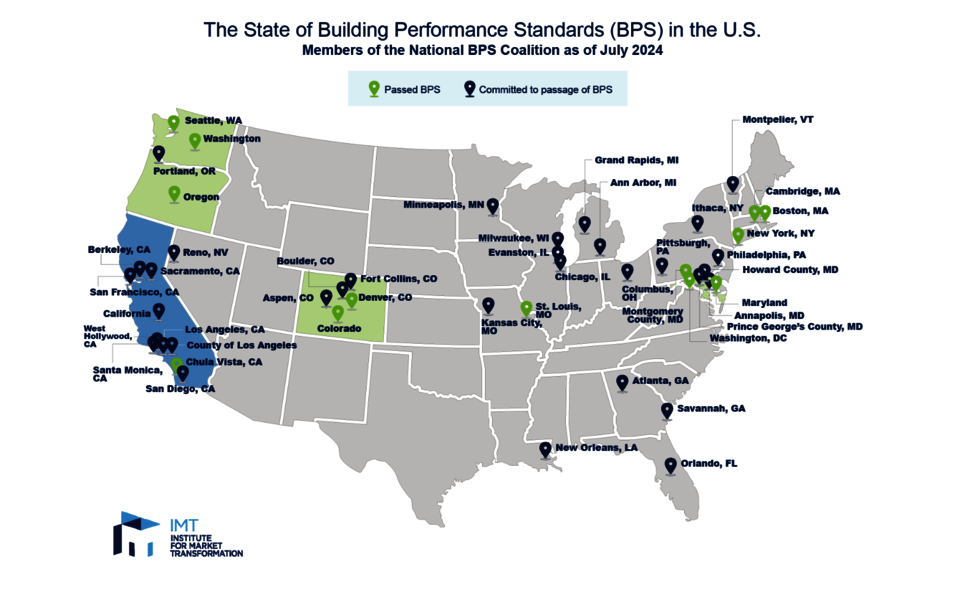Building Performance Standards 101: Enhancing sustainability in the built environment

By Kiwa Anisman, Policy Analyst
As our world grapples with climate change and the urgent need to reduce carbon emissions, Building Performance Standards (BPS) have emerged as powerful tools in shaping the future of our built environment. These policies set specific performance targets for buildings, aiming to enhance energy efficiency, reduce emissions, and promote sustainability. In this blog post, we’ll explore the essentials of BPS and their significance, and share a few notable examples in the U.S.
Understanding Building Performance Standards
What are BPS and why do they matter?
BPS define expectations for building performance through specific metrics. These standards can be adopted by state or local governments and often apply to existing commercial and multifamily buildings. While several jurisdictions have explored BPS policies, full implementation is still ongoing.
BPS policies serve several key purposes:
- Climate commitments from cities, states, and other governmental bodies: By setting performance targets, BPS policies contribute to achieving climate goals and reducing greenhouse gas (GHG) emissions from buildings.
- Energy efficiency and electrification: BPS encourage investments in energy-efficient technologies, benefiting both the environment and building owners. As BPS ramp up reliance on GHG metrics, electrification and fuel switching will become increasingly important.
- Stakeholder collaboration: Governments collaborate with building owners, utilities, and private entities to drive compliance and progress.
Key aspects of BPS
BPS focus on measurable outcomes and empower jurisdictions to drive change by requiring existing buildings to meet specific energy or emissions-based performance targets. Here are a few key elements:
- Covered buildings: BPS typically target commercial and multifamily buildings (sometimes public/government buildings as well) with sizes starting at 25,000 or 50,000 square feet, depending on jurisdiction.
- Outcome-based approach: Unlike traditional building codes that prescribe specific design elements, BPS emphasize results. For example, a jurisdiction might require buildings to achieve a certain level of energy use per square foot or meet specific GHG reduction goals.
- Timelines and milestones: BPS establish clear timelines for compliance. Imagine a city mandating that all buildings meet performance targets by December 2050, with interim goals in 2030 and 2040.
- Lifecycle perspective: BPS consider the entire lifecycle of a building, addressing new construction, existing structures, renovations, and ongoing operations.
- Noncompliance: Covered buildings will often face penalties or fees due to noncompliance with the standard and/or report as directed.

The National BPS Coalition and Earth Day goals
The National BPS Coalition, launched by the White House in January 2022, works closely with state and local governments to create a nationwide framework for sustainable buildings. The coalition plans to “identify and act on the prerequisites for building performance standards or other complementary policies and will work to advance legislation and/or regulation, with a goal of adoption by Earth Day 2024 (first cohort) or 2026 (second cohort)” (National BPS Coalition). While there is not significant movement of the first cohort documented by the National BPS Coalition, some jurisdictions have targeted lower hanging fruit, such as benchmarking ordinances or programs (City of Milwaukee).
Two U.S. examples of BPS
BPS have gained significant traction across the U.S. in recent years. More than a dozen jurisdictions, both state and local, have enacted BPS policies. Several other jurisdictions have pending BPS policies, indicating growing momentum for the adoption of BPS throughout the country. Additionally, the National BPS Coalition has grown to almost 40 active jurisdictions, demonstrating the unified commitment to implementing building performance policies and programs to ensure greener, healthier spaces for all.
1. New York City, NY
- Sustainable Buildings NYC (Local Law 97):
- Scope: Applies to commercial and multifamily buildings greater than or equal to 25,000 square feet.
- Performance Metrics:
- Annual GHG emissions (tCO2e/sq. ft.)
- Compliance Timeline:
- Covered buildings must file a report with the Department of Buildings by May 1, 2025, and by May 1 of every year thereafter.
- Emissions limits become more stringent every five years.
2. St. Louis, MO
- Building Energy Performance Standards (Ordinance 71132):
- Scope: Applies to public/government, commercial, and multifamily buildings greater than or equal to 50,000 square feet.
- Performance Metrics: Reduction in site energy use intensity (EUI).
- Compliance Timeline:
- Most properties must comply by May 4, 2025, to meet the standard.
Key takeaways
BPS will help pave the way towards a sustainable and resilient future. As cities and states continue to explore and implement BPS, we are collectively moving towards better, greener structures. Let’s embrace these standards and create a positive impact on our planet.
Want to chat more about BPS and learn how they might impact your company? Trio is here to discuss your unique circumstances and challenges in developing a bespoke strategy that ensures your company’s future success. Reach out to Sage.McLaughlin@trioadvisory.com.
